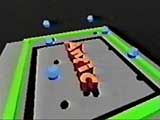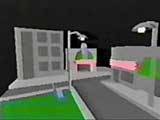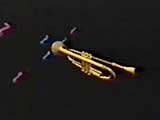QuickTime Gallery
That fact that this video animation could be produced at all is remarkable, especially when you consider that it was recorded to tape playing off the computer system, rather that output one frame at a time, which was the norm before around 1995. These animations were rendered at 320x200 pixels, utilizing only 16 carefully-selected colors at a time, out of a miniscule total palette of 512 colors. In order for them to play back, the entire animation had to be loaded into RAM, which was seldom more capacious than 4MB. Towards the end of the Atari era, a clever programmer -- Boris Tsikanovsky -- figured out a way to manipulate color lookup tables so that the full 512 color palette could be used for animation (see Spectrum 512 and Unispec for details); a couple examples of this technology are included below. In any case, it was generally not practical to produce an animated segment of any visual complexity that lasted more than about a minute. Nor was there enough colors or sufficient processing power to do real anti-aliasing, smooth shading, texture maps, reflections or specular highlights. However, this animation and software is what it is: a significant chapter and breeding ground in the origins of desktop video.
These QuickTime files were each prepared in one of two ways:
- most of the material was digitized from old VHS tapes; the signal was cleaned up with a DPS time-base-corrector and various JVC circuits and digitized to MiniDV; the DV data was transferred to a PC through a Canopus DV Raptor, edited in Adobe Premiere 6 and encoded with Apple QuickTime Pro
- the Cybermate sequences and some of the other animations were captured to AVI with TechSmith’s Camtasia as they played back in real-time from within the STEEM Atari ST emulator; the AVIs were then edited in Premiere 6 and encoded with QuickTime Pro; audio was prepared in Syntrillium’s Cool Edit 2000
All stills on this site were screen grabs from STEEM unless they were from video source, in which case they were saved from Premiere 6.
If you prefer, the same videos are all available in this Vimeo album:
https://vimeo.com/album/4603562.
Short clips
These are silent video clips of miscellaneous individual animations.
CyberMation demo reel

CyberMation is a sixteen minute demo reel in which all the visuals (except the live camera) were produced with Antic graphics software.
The entire video is about 73MB as a downloadable.
View reel (right-click to download)
Cybermate clips
These are video clips of Cybermate presentation, including sound effects created with G.I.S.T.

Darrel Anderson’s Cyberscape
Quicktime MOV (40MB)

Tom Hudson’s Spider Patrol
Quicktime MOV (56MB)
Desktop Video
The Macintosh and Aldus Pagemaker in the mid 1980’s created the Desktop Publishing industry, which enabled people with relatively inexpensive computers to do (somewhat) professional-grade page layout. Desktop Video is a concept that followed on the heels of Desktop Publishing and proposed to do the same for digital video production. Desktop Video exploded in the early 1990s led by Avid, and now is ubiquitous, particularly with the advent of the DV/miniDV camcorder.
























